As development has pushed into the Sonoran Desert, an unintended consequence has resulted in the introduction and spread of invasive plants into natural open spaces. Invasive plants are generally not native and tend to compete with and take over native plants. Unfortunately, due to landscaping and other choices on developed land outside but near the McDowell Sonoran Preserve, several invasive plants have been inadvertently introduced into the Preserve by windblown seeds or carried by birds, humans or water. The ecological damage caused by invasive plants negatively impacts the desert landscape by replacing native plants, damaging lands for animal habitat, eliminating preferred plants for forage and significantly increasing the risk of potential fire damage. All of these elements can permanently alter the landscape of our Sonoran Desert. Eight vegetation types have been identified to exist within the Preserve.
A brief description is outlined below in the order of most troublesome due to the fire danger and habitat degradation they each cause:
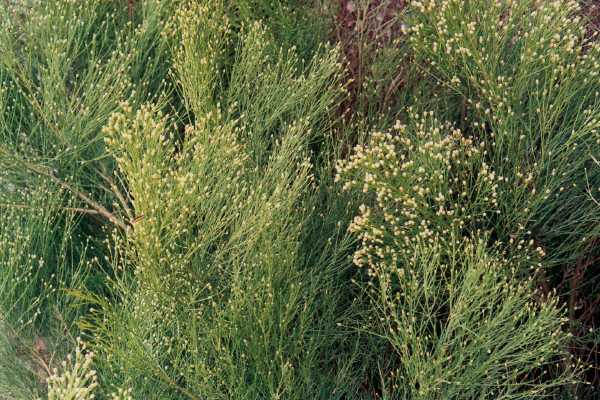 Desert Broom (Baccharis sarothroides) – native plant Desert Broom — even though it is a native — is viewed as being an invasive plant because of its aggressiveness in overtaking disturbed areas (such as roadsides and new landscaped areas), and because it burns fiercely and is a significant threat to nearby structures. It is almost always green, grows quickly to nearly 10-feet high. In autumn, the blooms, containing a mass of seeds with white bristles, easily become airborne and spread freely, clogging air conditioners and pool motors, and cluttering your home.To get rid of Desert Broom, apply non-diluted Round-Up using a paint brush to the exposed, cut stalks. Although you can dig out the stalks, this can be a difficult task. Desert Broom (Baccharis sarothroides) – native plant Desert Broom — even though it is a native — is viewed as being an invasive plant because of its aggressiveness in overtaking disturbed areas (such as roadsides and new landscaped areas), and because it burns fiercely and is a significant threat to nearby structures. It is almost always green, grows quickly to nearly 10-feet high. In autumn, the blooms, containing a mass of seeds with white bristles, easily become airborne and spread freely, clogging air conditioners and pool motors, and cluttering your home.To get rid of Desert Broom, apply non-diluted Round-Up using a paint brush to the exposed, cut stalks. Although you can dig out the stalks, this can be a difficult task. |
 Red Bromegrass (Bromus rubens) – non-native plant Found in very dense patches or widely dispersed as individual plants, the Red Bromegrass is a fast-growing, annual grass that reaches over 10 inches tall. Characteristic brush-like heads start out green in color, become reddish purple when mature and then light brown when seeds dry. The seed carrying portion of the grass have sharp ends and easily attach to animals or clothing for transport to other locations where the seeds then germinate. Red Bromegrass has become a major threat to the Sonoran Desert because it is so well established. Red Bromegrass (Bromus rubens) – non-native plant Found in very dense patches or widely dispersed as individual plants, the Red Bromegrass is a fast-growing, annual grass that reaches over 10 inches tall. Characteristic brush-like heads start out green in color, become reddish purple when mature and then light brown when seeds dry. The seed carrying portion of the grass have sharp ends and easily attach to animals or clothing for transport to other locations where the seeds then germinate. Red Bromegrass has become a major threat to the Sonoran Desert because it is so well established. |
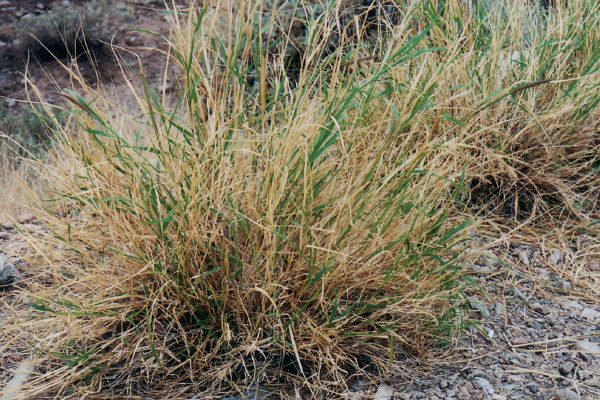 Buffel Grass (Pennisetum ciliare) – non-native plant This perennial bunchgrass grows up to four feet tall and has a mass of long, tough roots that can grow to eight feet deep. Narrow, light green leaves are one to four inches long. Bristly flower heads may be purple, gray or yellowish and turn a distinctive golden-brown when dry. Buffel Grass will burn while still green. When native plants die, Buffel Grass moves in and chokes out native seedlings. Buffel Grass (Pennisetum ciliare) – non-native plant This perennial bunchgrass grows up to four feet tall and has a mass of long, tough roots that can grow to eight feet deep. Narrow, light green leaves are one to four inches long. Bristly flower heads may be purple, gray or yellowish and turn a distinctive golden-brown when dry. Buffel Grass will burn while still green. When native plants die, Buffel Grass moves in and chokes out native seedlings. |
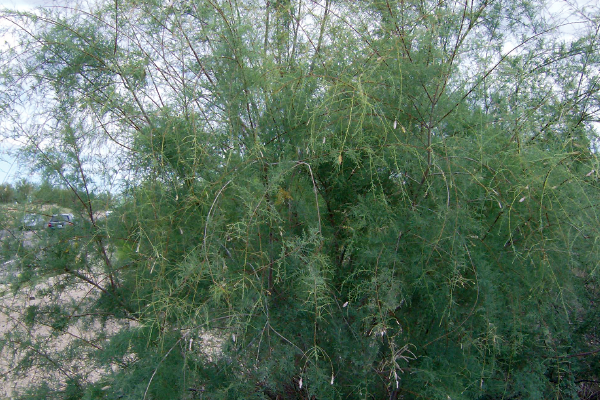 Tamarisk/Salt Cedar (Tamarix spp.) – non-native plant This shrubby tree grows up to 15-feet with gray-green foliage and slender branches. Pink-white flowers appear from January to October. Tamarisk spreads rapidly and forms dense thickets. Once established, it is difficult to eradicate. These trees use large amounts of ground water causing desert springs to dry up and crowding out native trees such as cottonwood, mesquite and desert willow. Because this plant is difficult to remove, it is advised to contact a specialist if you detect a Tamarisk in your area or in the Preserve. Tamarisk/Salt Cedar (Tamarix spp.) – non-native plant This shrubby tree grows up to 15-feet with gray-green foliage and slender branches. Pink-white flowers appear from January to October. Tamarisk spreads rapidly and forms dense thickets. Once established, it is difficult to eradicate. These trees use large amounts of ground water causing desert springs to dry up and crowding out native trees such as cottonwood, mesquite and desert willow. Because this plant is difficult to remove, it is advised to contact a specialist if you detect a Tamarisk in your area or in the Preserve. |
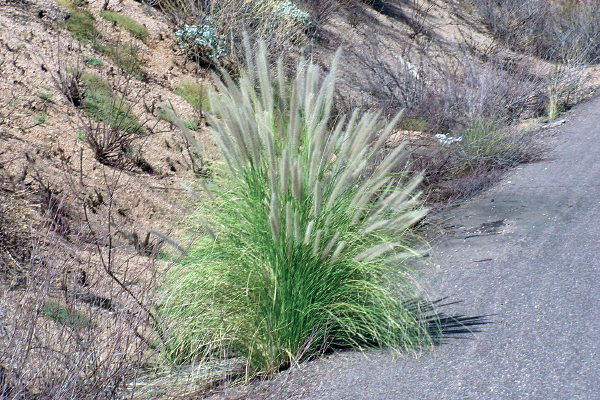 Fountain Grass (Pennisetum setaceum) – non-native plant This perennial bunchgrass grows up to 3-feet high and has long, slender green leaves and purple to white feathery spikes. Fountain Grass is a highly aggressive, fire-adapted species that crowds out native plants and spreads quickly. Fountain Grass has been used in landscaping. Native ornamental grasses should be used instead of Fountain Grass. Alternatives: Purple Threeawn, Arizona Cotton Top or Bull Grass. Fountain Grass (Pennisetum setaceum) – non-native plant This perennial bunchgrass grows up to 3-feet high and has long, slender green leaves and purple to white feathery spikes. Fountain Grass is a highly aggressive, fire-adapted species that crowds out native plants and spreads quickly. Fountain Grass has been used in landscaping. Native ornamental grasses should be used instead of Fountain Grass. Alternatives: Purple Threeawn, Arizona Cotton Top or Bull Grass. |
 Malta Starthistle (Centaurea melitensis) – non-native plant This erect, winter annual grows up to 2-feet tall and in dense stands. It has grayish-green foliage and yellow, thistle-like flowers with sharp spines of a purplish or brown color that appear in May and June. Malta Starthistle aggressively competes for space with native species and reduces wildlife habitat and food. Malta Starthistle (Centaurea melitensis) – non-native plant This erect, winter annual grows up to 2-feet tall and in dense stands. It has grayish-green foliage and yellow, thistle-like flowers with sharp spines of a purplish or brown color that appear in May and June. Malta Starthistle aggressively competes for space with native species and reduces wildlife habitat and food. |
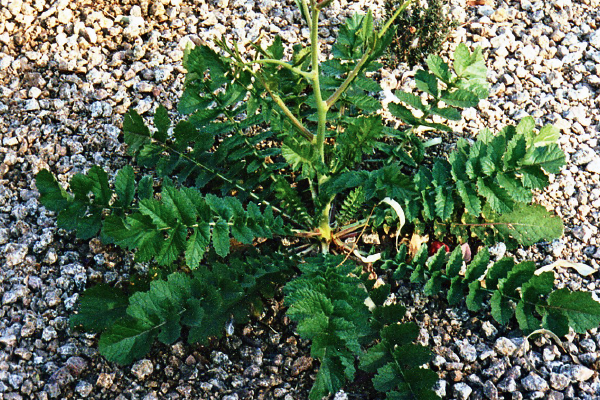 Saharan Mustard (Brassica tournefortii) – non-native plant This annual, spring herb forms rosettes 6- to 12-inches in diameter. Leaves vary in size and have tiny bristles on the undersides. Small pale yellow flowers appear from January to April or May. Tiny reddish seeds are formed in narrow pods. Saharan Mustard can grow in large stands, creating barriers to normal wildlife movement when plants are alive. As desert temperatures rise, parts of the plant die and increase wildfire fuel loads dramatically. Saharan Mustard (Brassica tournefortii) – non-native plant This annual, spring herb forms rosettes 6- to 12-inches in diameter. Leaves vary in size and have tiny bristles on the undersides. Small pale yellow flowers appear from January to April or May. Tiny reddish seeds are formed in narrow pods. Saharan Mustard can grow in large stands, creating barriers to normal wildlife movement when plants are alive. As desert temperatures rise, parts of the plant die and increase wildfire fuel loads dramatically. |
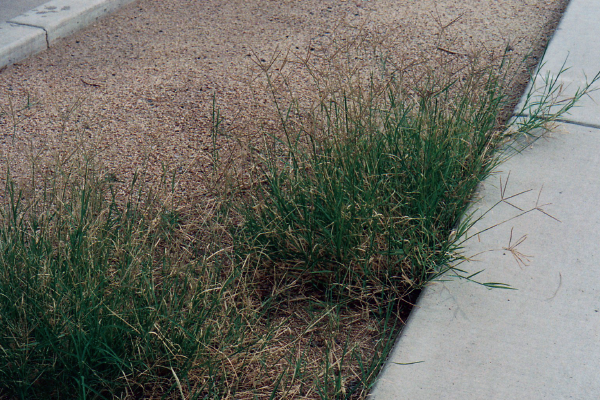 Bermuda Grass (Cynodon dactylon) – non-native plant This perennial grass is common to many lawns in southern regions and grows well in our hot, desert climate. It is the most common summer lawn choice in the desert southwest. Bermuda Grass competes with native plants and invades disturbed areas. It is a leading cause of hay fever in the Sonoran Desert. Bermuda Grass (Cynodon dactylon) – non-native plant This perennial grass is common to many lawns in southern regions and grows well in our hot, desert climate. It is the most common summer lawn choice in the desert southwest. Bermuda Grass competes with native plants and invades disturbed areas. It is a leading cause of hay fever in the Sonoran Desert.
|
As a resident of North Scottsdale, you can help by:
- Learning to identify problem plants;
- Removing invasive weeds from private property;
- Allowing native plants to take priority in your own yard;
- Reporting infestations in common areas to homeowner association board;
- Adding these plants to your homeowner associations’ prohibited plant lists;
- Learning about proper eradication methods;
- Joining a recognized volunteer weed removal group,
- Getting trained and participating;
- Asking plant nurseries to stop carrying these plants; and
- Helping the Scottsdale Fire Department by providing defensible space on the portions of your property that are nearest to structures and adjacent to natural Sonoran Desert areas.
PLEASE NOTE: You can not touch any areas outside your property line. If you have concerns, contact the property manager.

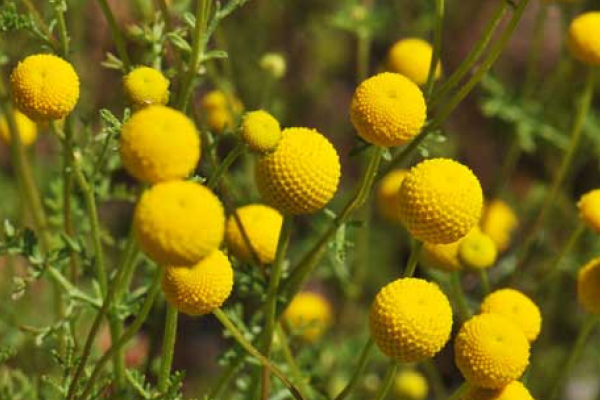 Globe Chamomile (Oncosiphon piluliferum)
Globe Chamomile (Oncosiphon piluliferum)